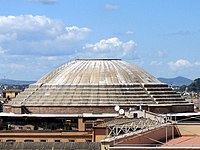
Photo from wikipedia
Abstract This research evaluates the engineering properties of waste foundry sand (WFS) as a sustainable construction material. In this research study, extensive laboratory experiments, including X-ray fluorescence (XRF), pH value,… Click to show full abstract
Abstract This research evaluates the engineering properties of waste foundry sand (WFS) as a sustainable construction material. In this research study, extensive laboratory experiments, including X-ray fluorescence (XRF), pH value, particle size distribution, California bearing ratio (CBR) and consolidated drained (CD) direct shear and CD triaxial tests were conducted. In addition, for the comparison purpose, a similar testing program was applied to a control material, namely sand sized waste recycled glass (RG), which is an accepted construction material for geotechnical and pavement construction projects. Results indicated that although the strength properties of WFS were lower than those of RG, the WFS could meet the required characteristics to be used in applications such as engineering fill and road embankments. The outcomes of this research aim to increase the market demand for WFS as a solid waste by improving the construction industry’s confidence in its performance. Using WFS as an alternative to natural sands in the construction activities can potentially have significant positive environmental impacts through reducing CO2 emission, as well as preventing the expansion of landfills for the disposal of WFS.
Journal Title: Construction and Building Materials
Year Published: 2020
Link to full text (if available)
Share on Social Media: Sign Up to like & get
recommendations!